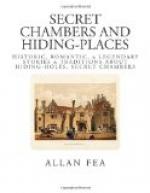When Slindon House, Sussex, was undergoing some restorations, a “priest’s hole” communicating with the roof was discovered. It contained some ancient devotional books, and against the walls were hung stout leathern straps, by which a person could let himself down.
The internal arrangements at Plowden Hall, Shropshire, give one a good idea of the feeling of insecurity that must have been so prevalent in those “good old days.” Running from the top of the house there is in the thickness of the wall, a concealed circular shoot about a couple of feet in diameter, through which a person could lower himself, if necessary, to the ground floor by the aid of a rope. Here also, beneath the floor-boards of a cupboard in one of the bedrooms, is a concealed chamber with a fixed shelf, presumably provided to act as a sort of table for the unfortunate individual who was forced to occupy the narrow limits of the room. Years before this hiding-place was opened to the light of day (in the course of some alterations to the house), its existence and actual position was well known; still, strange to say, the way into it had never been discovered.
CHAPTER VII
KING-HUNTING: BOSCOBEL, MOSELEY, TRENT, AND HEALE
When the Civil War was raging, many a defeated cavalier owed his preservation to the “priests’ holes” and secret chambers of the old Roman Catholic houses all over the country. Did not Charles II. himself owe his life to the conveniences offered at Boscobel, Moseley, Trent, and Heale? We have elsewhere[1] gone minutely into the young king’s hair-breadth adventures; but the story is so closely connected with the present subject that we must record something of his sojourn at these four old houses, as from an historical point of view they are of exceptional interest, if one but considers how the order of things would have been changed had either of these hiding-places been discovered at the time “his Sacred Majesty” occupied them. It is vain to speculate upon the probabilities; still, there is no ignoring the fact that had Charles been captured he would have shared the fate of his father.
[Footnote 1: See The Flight of the King.]
[Illustration: HIDING-PLACE BENEATH “THE CHAPEL,” BOSCOBEL, SALOP]
[Illustration: ENTRANCE TO HIDING-PLACE IN “THE GARRET” OR “CHAPEL,” BOSCOBEL]
[Illustration: HIDING-PLACE IN “THE SQUIRE’S BEDROOM,” BOSCOBEL]
[Illustration: SECRET PANEL, TRENT HOUSE, SOMERSETSHIRE]
[Illustration: BOSCOBEL, SALOP]
[Illustration: HIDING-PLACE, TRENT HOUSE]
[Illustration: ENTRANCE TO HIDING-PLACE, TRENT HOUSE]
[Illustration: TRENT HOUSE IN 1864]
[Illustration: HEALE HOUSE, WILTSHIRE]
After the defeat of Wigan, the gallant Earl of Derby sought refuge at the isolated, wood-surrounded hunting-lodge of Boscobel, and after remaining there concealed for two days, proceeded to Gatacre Park, now rebuilt, but then and for long after famous for its secret chambers. Here he remained hidden prior to the disastrous battle of Worcester.




